Analyzing the Profound Impacts of Digital Technology on Society
VerifiedAdded on 2022/04/01
|9
|2159
|26
Essay
AI Summary
This essay delves into the multifaceted effects of digital technology on contemporary society. It begins by highlighting the increasing global usage of digital tools like smartphones and the internet, emphasizing both the benefits and challenges associated with this technological shift. The essay explores the impact on various cultural forms, including visual arts, literature, music, and interactive multimedia, showcasing how digital tools have reshaped creative processes and audience engagement. It discusses the physiological and psychological effects of digital media, including the potential for addiction and altered brain functions, while also acknowledging the positive impacts on complex reasoning and global connectivity. The paper references scholarly research, providing a comprehensive overview of the ongoing transformation driven by digital technology and its pervasive influence on human life, from personal interactions to professional environments.
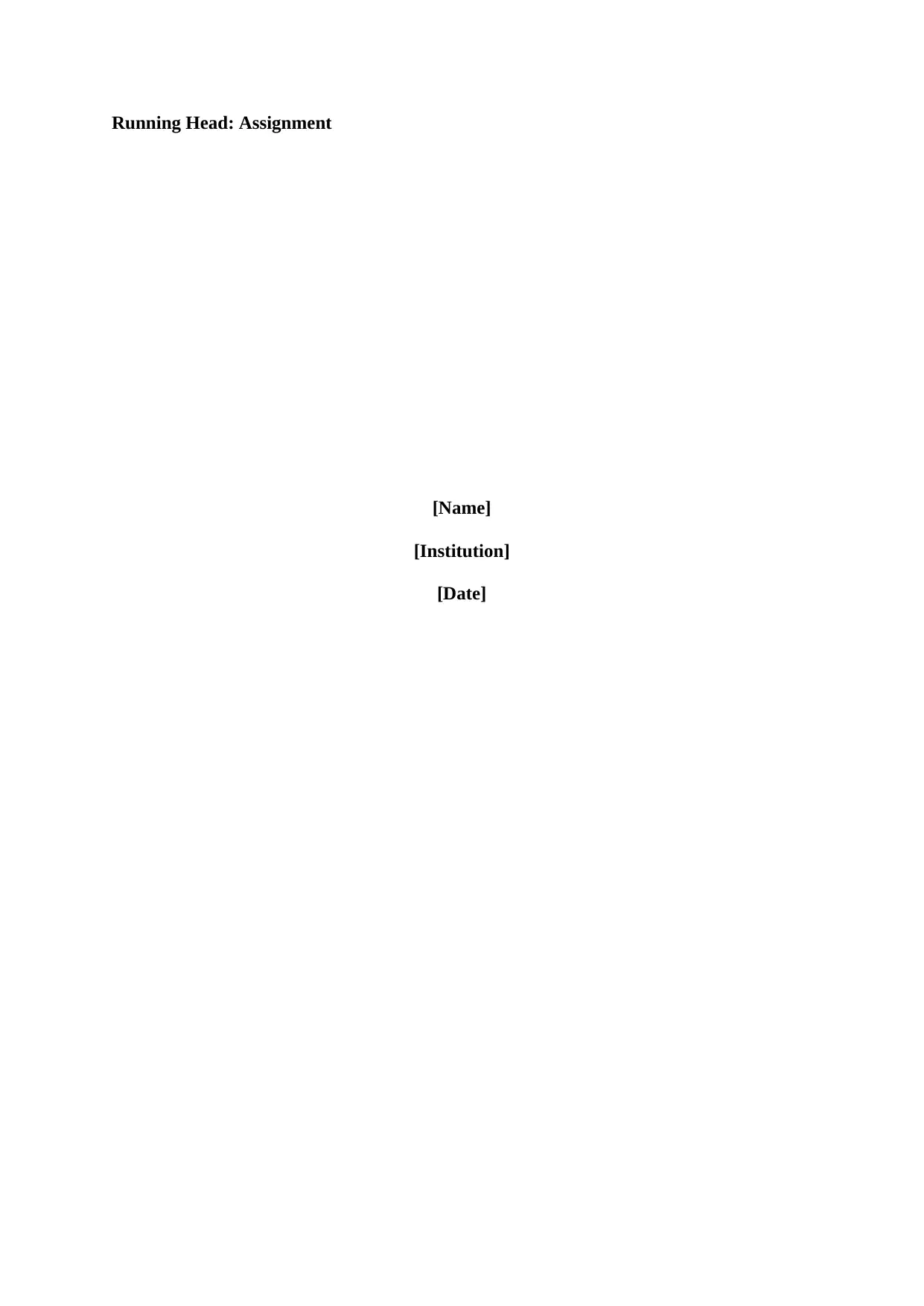
Running Head: Assignment
[Name]
[Institution]
[Date]
[Name]
[Institution]
[Date]
Paraphrase This Document
Need a fresh take? Get an instant paraphrase of this document with our AI Paraphraser
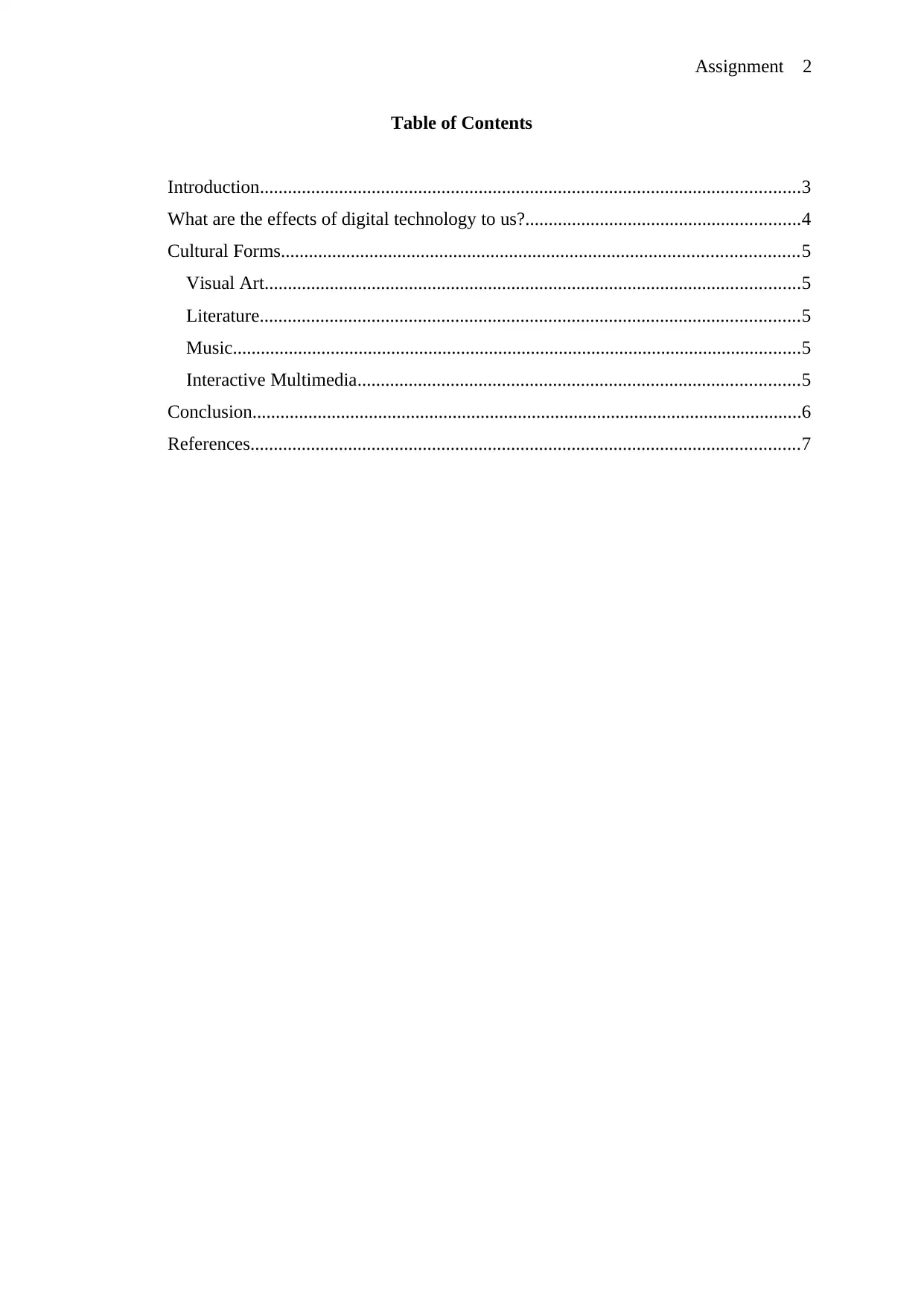
Assignment 2
Table of Contents
Introduction....................................................................................................................3
What are the effects of digital technology to us?...........................................................4
Cultural Forms...............................................................................................................5
Visual Art...................................................................................................................5
Literature....................................................................................................................5
Music..........................................................................................................................5
Interactive Multimedia...............................................................................................5
Conclusion......................................................................................................................6
References......................................................................................................................7
Table of Contents
Introduction....................................................................................................................3
What are the effects of digital technology to us?...........................................................4
Cultural Forms...............................................................................................................5
Visual Art...................................................................................................................5
Literature....................................................................................................................5
Music..........................................................................................................................5
Interactive Multimedia...............................................................................................5
Conclusion......................................................................................................................6
References......................................................................................................................7
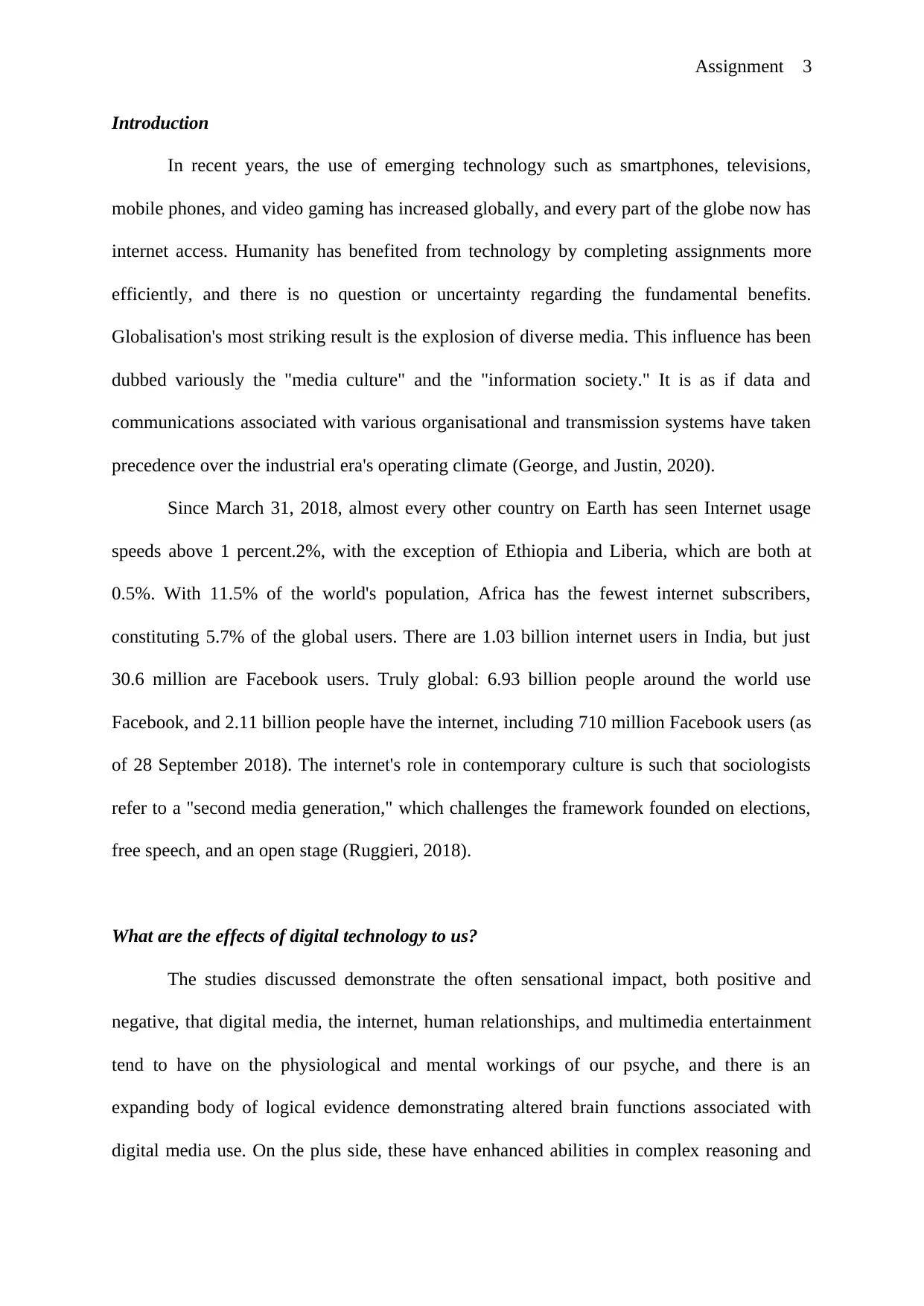
Assignment 3
Introduction
In recent years, the use of emerging technology such as smartphones, televisions,
mobile phones, and video gaming has increased globally, and every part of the globe now has
internet access. Humanity has benefited from technology by completing assignments more
efficiently, and there is no question or uncertainty regarding the fundamental benefits.
Globalisation's most striking result is the explosion of diverse media. This influence has been
dubbed variously the "media culture" and the "information society." It is as if data and
communications associated with various organisational and transmission systems have taken
precedence over the industrial era's operating climate (George, and Justin, 2020).
Since March 31, 2018, almost every other country on Earth has seen Internet usage
speeds above 1 percent.2%, with the exception of Ethiopia and Liberia, which are both at
0.5%. With 11.5% of the world's population, Africa has the fewest internet subscribers,
constituting 5.7% of the global users. There are 1.03 billion internet users in India, but just
30.6 million are Facebook users. Truly global: 6.93 billion people around the world use
Facebook, and 2.11 billion people have the internet, including 710 million Facebook users (as
of 28 September 2018). The internet's role in contemporary culture is such that sociologists
refer to a "second media generation," which challenges the framework founded on elections,
free speech, and an open stage (Ruggieri, 2018).
What are the effects of digital technology to us?
The studies discussed demonstrate the often sensational impact, both positive and
negative, that digital media, the internet, human relationships, and multimedia entertainment
tend to have on the physiological and mental workings of our psyche, and there is an
expanding body of logical evidence demonstrating altered brain functions associated with
digital media use. On the plus side, these have enhanced abilities in complex reasoning and
Introduction
In recent years, the use of emerging technology such as smartphones, televisions,
mobile phones, and video gaming has increased globally, and every part of the globe now has
internet access. Humanity has benefited from technology by completing assignments more
efficiently, and there is no question or uncertainty regarding the fundamental benefits.
Globalisation's most striking result is the explosion of diverse media. This influence has been
dubbed variously the "media culture" and the "information society." It is as if data and
communications associated with various organisational and transmission systems have taken
precedence over the industrial era's operating climate (George, and Justin, 2020).
Since March 31, 2018, almost every other country on Earth has seen Internet usage
speeds above 1 percent.2%, with the exception of Ethiopia and Liberia, which are both at
0.5%. With 11.5% of the world's population, Africa has the fewest internet subscribers,
constituting 5.7% of the global users. There are 1.03 billion internet users in India, but just
30.6 million are Facebook users. Truly global: 6.93 billion people around the world use
Facebook, and 2.11 billion people have the internet, including 710 million Facebook users (as
of 28 September 2018). The internet's role in contemporary culture is such that sociologists
refer to a "second media generation," which challenges the framework founded on elections,
free speech, and an open stage (Ruggieri, 2018).
What are the effects of digital technology to us?
The studies discussed demonstrate the often sensational impact, both positive and
negative, that digital media, the internet, human relationships, and multimedia entertainment
tend to have on the physiological and mental workings of our psyche, and there is an
expanding body of logical evidence demonstrating altered brain functions associated with
digital media use. On the plus side, these have enhanced abilities in complex reasoning and
⊘ This is a preview!⊘
Do you want full access?
Subscribe today to unlock all pages.

Trusted by 1+ million students worldwide
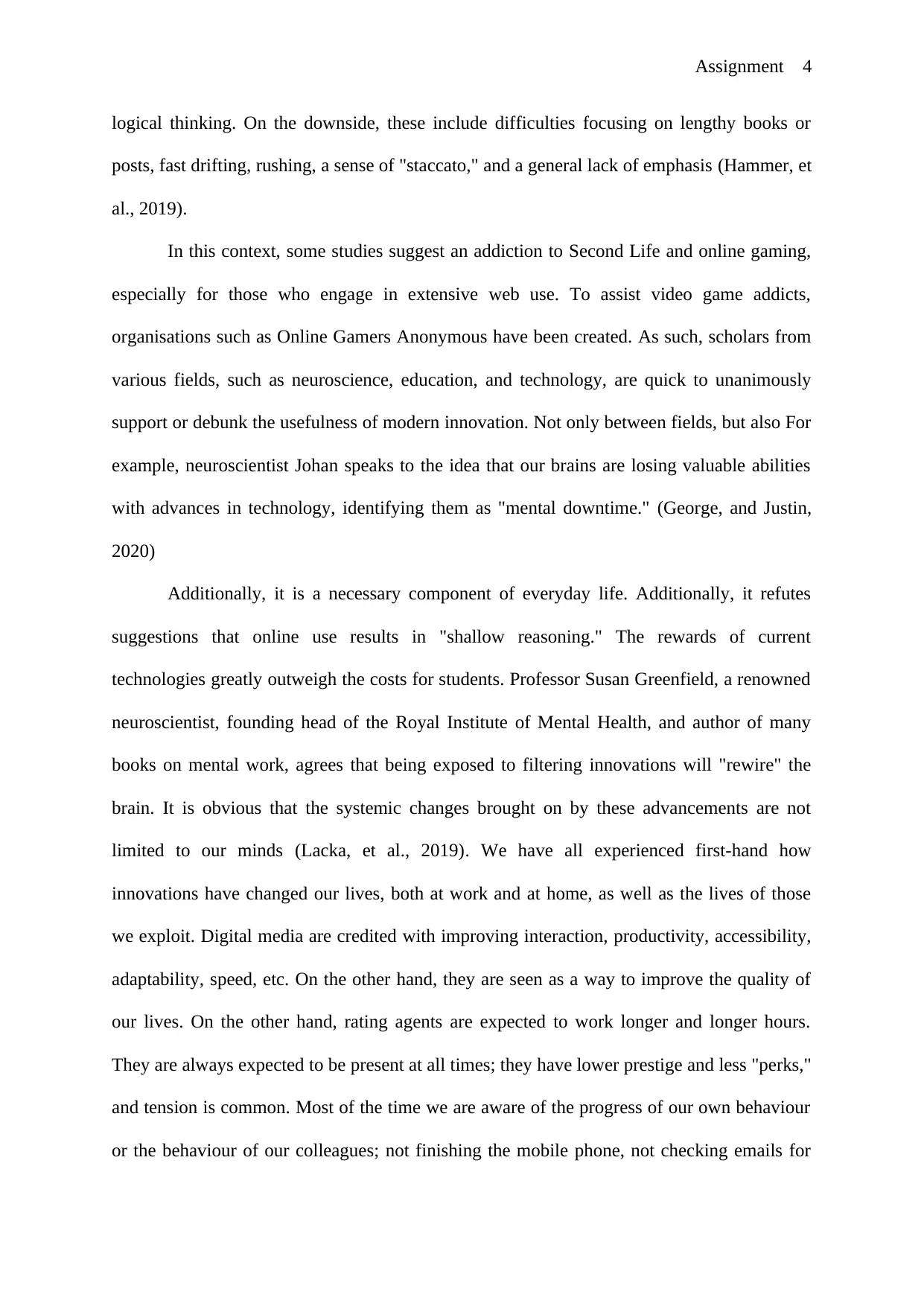
Assignment 4
logical thinking. On the downside, these include difficulties focusing on lengthy books or
posts, fast drifting, rushing, a sense of "staccato," and a general lack of emphasis (Hammer, et
al., 2019).
In this context, some studies suggest an addiction to Second Life and online gaming,
especially for those who engage in extensive web use. To assist video game addicts,
organisations such as Online Gamers Anonymous have been created. As such, scholars from
various fields, such as neuroscience, education, and technology, are quick to unanimously
support or debunk the usefulness of modern innovation. Not only between fields, but also For
example, neuroscientist Johan speaks to the idea that our brains are losing valuable abilities
with advances in technology, identifying them as "mental downtime." (George, and Justin,
2020)
Additionally, it is a necessary component of everyday life. Additionally, it refutes
suggestions that online use results in "shallow reasoning." The rewards of current
technologies greatly outweigh the costs for students. Professor Susan Greenfield, a renowned
neuroscientist, founding head of the Royal Institute of Mental Health, and author of many
books on mental work, agrees that being exposed to filtering innovations will "rewire" the
brain. It is obvious that the systemic changes brought on by these advancements are not
limited to our minds (Lacka, et al., 2019). We have all experienced first-hand how
innovations have changed our lives, both at work and at home, as well as the lives of those
we exploit. Digital media are credited with improving interaction, productivity, accessibility,
adaptability, speed, etc. On the other hand, they are seen as a way to improve the quality of
our lives. On the other hand, rating agents are expected to work longer and longer hours.
They are always expected to be present at all times; they have lower prestige and less "perks,"
and tension is common. Most of the time we are aware of the progress of our own behaviour
or the behaviour of our colleagues; not finishing the mobile phone, not checking emails for
logical thinking. On the downside, these include difficulties focusing on lengthy books or
posts, fast drifting, rushing, a sense of "staccato," and a general lack of emphasis (Hammer, et
al., 2019).
In this context, some studies suggest an addiction to Second Life and online gaming,
especially for those who engage in extensive web use. To assist video game addicts,
organisations such as Online Gamers Anonymous have been created. As such, scholars from
various fields, such as neuroscience, education, and technology, are quick to unanimously
support or debunk the usefulness of modern innovation. Not only between fields, but also For
example, neuroscientist Johan speaks to the idea that our brains are losing valuable abilities
with advances in technology, identifying them as "mental downtime." (George, and Justin,
2020)
Additionally, it is a necessary component of everyday life. Additionally, it refutes
suggestions that online use results in "shallow reasoning." The rewards of current
technologies greatly outweigh the costs for students. Professor Susan Greenfield, a renowned
neuroscientist, founding head of the Royal Institute of Mental Health, and author of many
books on mental work, agrees that being exposed to filtering innovations will "rewire" the
brain. It is obvious that the systemic changes brought on by these advancements are not
limited to our minds (Lacka, et al., 2019). We have all experienced first-hand how
innovations have changed our lives, both at work and at home, as well as the lives of those
we exploit. Digital media are credited with improving interaction, productivity, accessibility,
adaptability, speed, etc. On the other hand, they are seen as a way to improve the quality of
our lives. On the other hand, rating agents are expected to work longer and longer hours.
They are always expected to be present at all times; they have lower prestige and less "perks,"
and tension is common. Most of the time we are aware of the progress of our own behaviour
or the behaviour of our colleagues; not finishing the mobile phone, not checking emails for
Paraphrase This Document
Need a fresh take? Get an instant paraphrase of this document with our AI Paraphraser
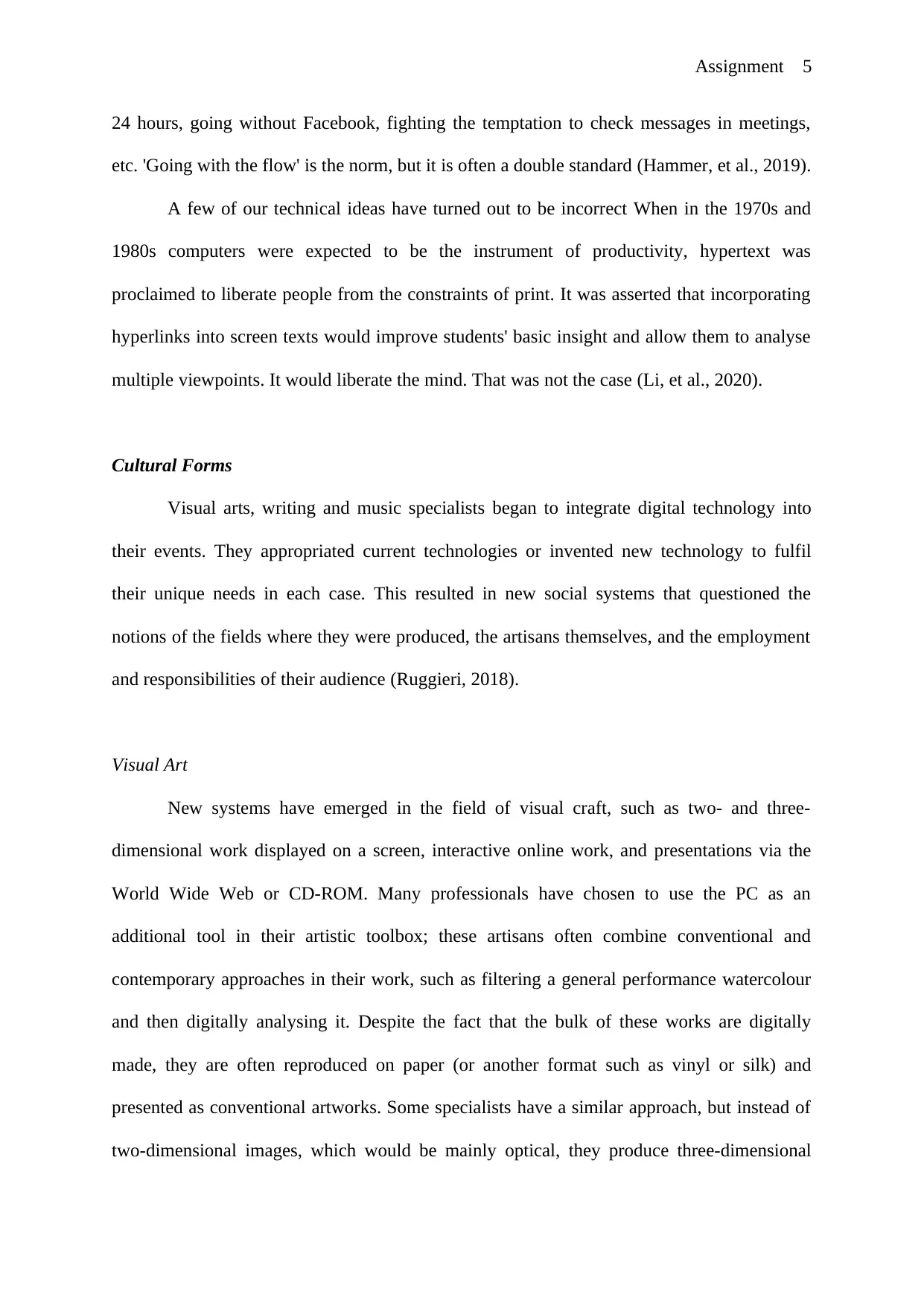
Assignment 5
24 hours, going without Facebook, fighting the temptation to check messages in meetings,
etc. 'Going with the flow' is the norm, but it is often a double standard (Hammer, et al., 2019).
A few of our technical ideas have turned out to be incorrect When in the 1970s and
1980s computers were expected to be the instrument of productivity, hypertext was
proclaimed to liberate people from the constraints of print. It was asserted that incorporating
hyperlinks into screen texts would improve students' basic insight and allow them to analyse
multiple viewpoints. It would liberate the mind. That was not the case (Li, et al., 2020).
Cultural Forms
Visual arts, writing and music specialists began to integrate digital technology into
their events. They appropriated current technologies or invented new technology to fulfil
their unique needs in each case. This resulted in new social systems that questioned the
notions of the fields where they were produced, the artisans themselves, and the employment
and responsibilities of their audience (Ruggieri, 2018).
Visual Art
New systems have emerged in the field of visual craft, such as two- and three-
dimensional work displayed on a screen, interactive online work, and presentations via the
World Wide Web or CD-ROM. Many professionals have chosen to use the PC as an
additional tool in their artistic toolbox; these artisans often combine conventional and
contemporary approaches in their work, such as filtering a general performance watercolour
and then digitally analysing it. Despite the fact that the bulk of these works are digitally
made, they are often reproduced on paper (or another format such as vinyl or silk) and
presented as conventional artworks. Some specialists have a similar approach, but instead of
two-dimensional images, which would be mainly optical, they produce three-dimensional
24 hours, going without Facebook, fighting the temptation to check messages in meetings,
etc. 'Going with the flow' is the norm, but it is often a double standard (Hammer, et al., 2019).
A few of our technical ideas have turned out to be incorrect When in the 1970s and
1980s computers were expected to be the instrument of productivity, hypertext was
proclaimed to liberate people from the constraints of print. It was asserted that incorporating
hyperlinks into screen texts would improve students' basic insight and allow them to analyse
multiple viewpoints. It would liberate the mind. That was not the case (Li, et al., 2020).
Cultural Forms
Visual arts, writing and music specialists began to integrate digital technology into
their events. They appropriated current technologies or invented new technology to fulfil
their unique needs in each case. This resulted in new social systems that questioned the
notions of the fields where they were produced, the artisans themselves, and the employment
and responsibilities of their audience (Ruggieri, 2018).
Visual Art
New systems have emerged in the field of visual craft, such as two- and three-
dimensional work displayed on a screen, interactive online work, and presentations via the
World Wide Web or CD-ROM. Many professionals have chosen to use the PC as an
additional tool in their artistic toolbox; these artisans often combine conventional and
contemporary approaches in their work, such as filtering a general performance watercolour
and then digitally analysing it. Despite the fact that the bulk of these works are digitally
made, they are often reproduced on paper (or another format such as vinyl or silk) and
presented as conventional artworks. Some specialists have a similar approach, but instead of
two-dimensional images, which would be mainly optical, they produce three-dimensional
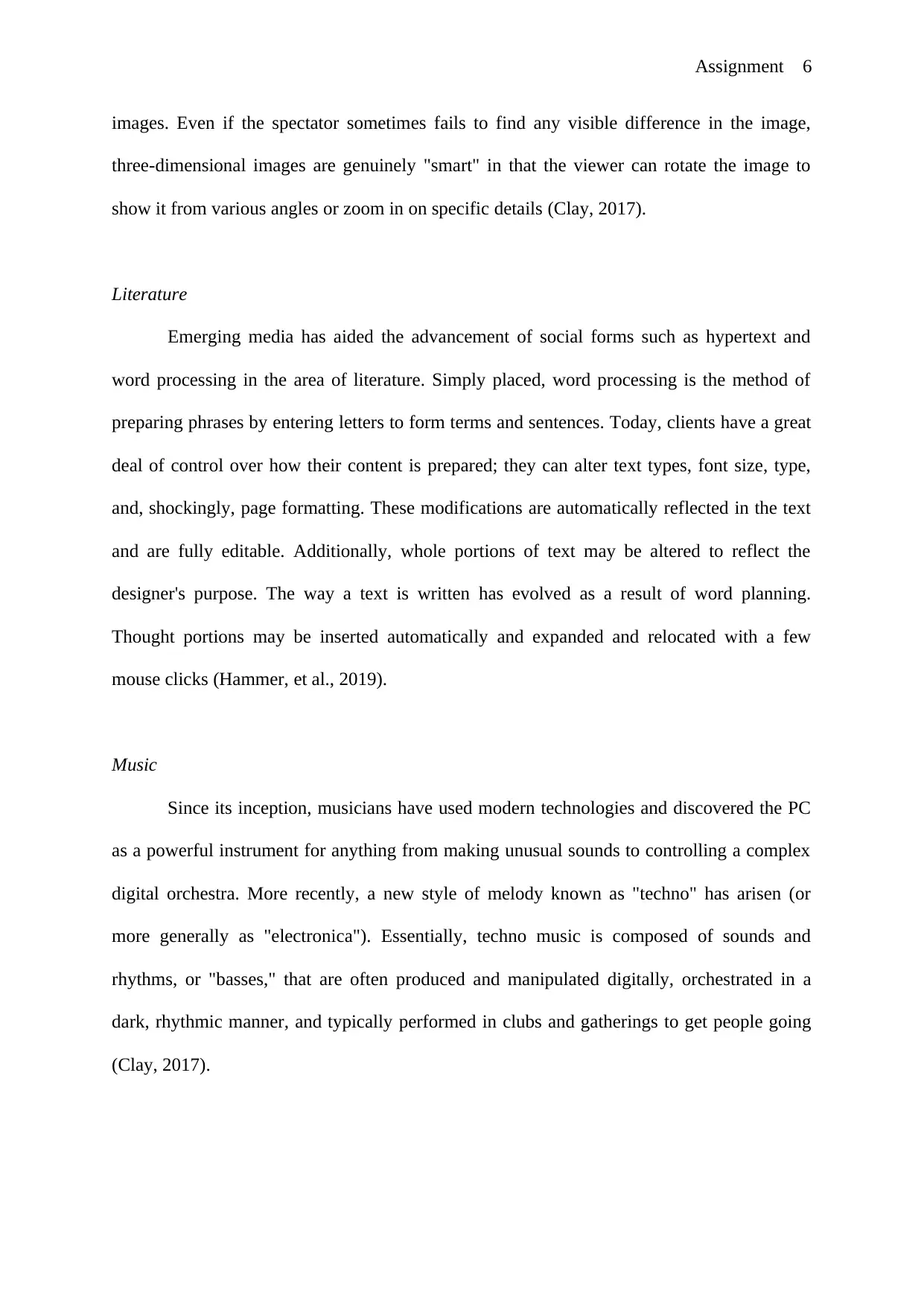
Assignment 6
images. Even if the spectator sometimes fails to find any visible difference in the image,
three-dimensional images are genuinely "smart" in that the viewer can rotate the image to
show it from various angles or zoom in on specific details (Clay, 2017).
Literature
Emerging media has aided the advancement of social forms such as hypertext and
word processing in the area of literature. Simply placed, word processing is the method of
preparing phrases by entering letters to form terms and sentences. Today, clients have a great
deal of control over how their content is prepared; they can alter text types, font size, type,
and, shockingly, page formatting. These modifications are automatically reflected in the text
and are fully editable. Additionally, whole portions of text may be altered to reflect the
designer's purpose. The way a text is written has evolved as a result of word planning.
Thought portions may be inserted automatically and expanded and relocated with a few
mouse clicks (Hammer, et al., 2019).
Music
Since its inception, musicians have used modern technologies and discovered the PC
as a powerful instrument for anything from making unusual sounds to controlling a complex
digital orchestra. More recently, a new style of melody known as "techno" has arisen (or
more generally as "electronica"). Essentially, techno music is composed of sounds and
rhythms, or "basses," that are often produced and manipulated digitally, orchestrated in a
dark, rhythmic manner, and typically performed in clubs and gatherings to get people going
(Clay, 2017).
images. Even if the spectator sometimes fails to find any visible difference in the image,
three-dimensional images are genuinely "smart" in that the viewer can rotate the image to
show it from various angles or zoom in on specific details (Clay, 2017).
Literature
Emerging media has aided the advancement of social forms such as hypertext and
word processing in the area of literature. Simply placed, word processing is the method of
preparing phrases by entering letters to form terms and sentences. Today, clients have a great
deal of control over how their content is prepared; they can alter text types, font size, type,
and, shockingly, page formatting. These modifications are automatically reflected in the text
and are fully editable. Additionally, whole portions of text may be altered to reflect the
designer's purpose. The way a text is written has evolved as a result of word planning.
Thought portions may be inserted automatically and expanded and relocated with a few
mouse clicks (Hammer, et al., 2019).
Music
Since its inception, musicians have used modern technologies and discovered the PC
as a powerful instrument for anything from making unusual sounds to controlling a complex
digital orchestra. More recently, a new style of melody known as "techno" has arisen (or
more generally as "electronica"). Essentially, techno music is composed of sounds and
rhythms, or "basses," that are often produced and manipulated digitally, orchestrated in a
dark, rhythmic manner, and typically performed in clubs and gatherings to get people going
(Clay, 2017).
⊘ This is a preview!⊘
Do you want full access?
Subscribe today to unlock all pages.

Trusted by 1+ million students worldwide
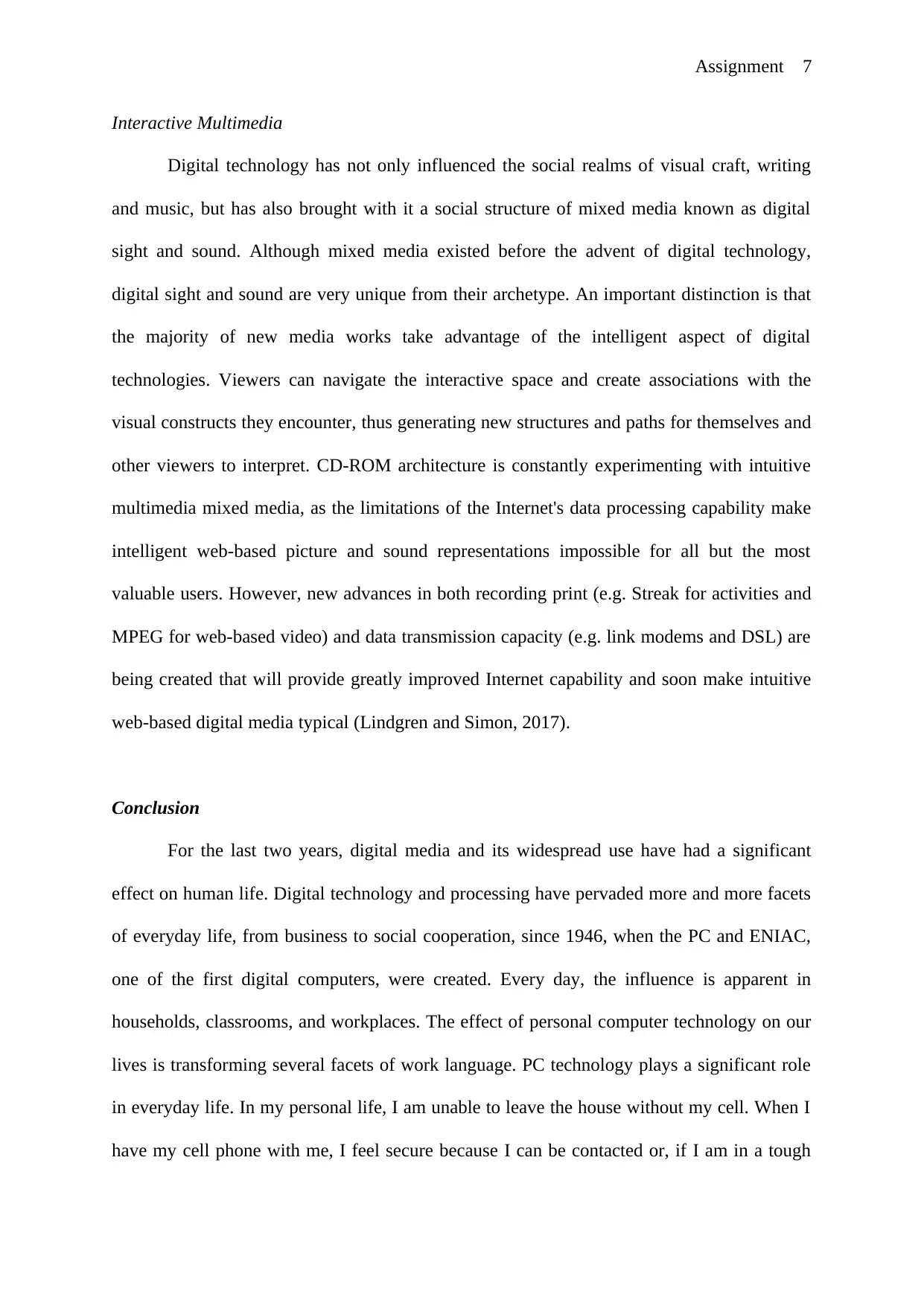
Assignment 7
Interactive Multimedia
Digital technology has not only influenced the social realms of visual craft, writing
and music, but has also brought with it a social structure of mixed media known as digital
sight and sound. Although mixed media existed before the advent of digital technology,
digital sight and sound are very unique from their archetype. An important distinction is that
the majority of new media works take advantage of the intelligent aspect of digital
technologies. Viewers can navigate the interactive space and create associations with the
visual constructs they encounter, thus generating new structures and paths for themselves and
other viewers to interpret. CD-ROM architecture is constantly experimenting with intuitive
multimedia mixed media, as the limitations of the Internet's data processing capability make
intelligent web-based picture and sound representations impossible for all but the most
valuable users. However, new advances in both recording print (e.g. Streak for activities and
MPEG for web-based video) and data transmission capacity (e.g. link modems and DSL) are
being created that will provide greatly improved Internet capability and soon make intuitive
web-based digital media typical (Lindgren and Simon, 2017).
Conclusion
For the last two years, digital media and its widespread use have had a significant
effect on human life. Digital technology and processing have pervaded more and more facets
of everyday life, from business to social cooperation, since 1946, when the PC and ENIAC,
one of the first digital computers, were created. Every day, the influence is apparent in
households, classrooms, and workplaces. The effect of personal computer technology on our
lives is transforming several facets of work language. PC technology plays a significant role
in everyday life. In my personal life, I am unable to leave the house without my cell. When I
have my cell phone with me, I feel secure because I can be contacted or, if I am in a tough
Interactive Multimedia
Digital technology has not only influenced the social realms of visual craft, writing
and music, but has also brought with it a social structure of mixed media known as digital
sight and sound. Although mixed media existed before the advent of digital technology,
digital sight and sound are very unique from their archetype. An important distinction is that
the majority of new media works take advantage of the intelligent aspect of digital
technologies. Viewers can navigate the interactive space and create associations with the
visual constructs they encounter, thus generating new structures and paths for themselves and
other viewers to interpret. CD-ROM architecture is constantly experimenting with intuitive
multimedia mixed media, as the limitations of the Internet's data processing capability make
intelligent web-based picture and sound representations impossible for all but the most
valuable users. However, new advances in both recording print (e.g. Streak for activities and
MPEG for web-based video) and data transmission capacity (e.g. link modems and DSL) are
being created that will provide greatly improved Internet capability and soon make intuitive
web-based digital media typical (Lindgren and Simon, 2017).
Conclusion
For the last two years, digital media and its widespread use have had a significant
effect on human life. Digital technology and processing have pervaded more and more facets
of everyday life, from business to social cooperation, since 1946, when the PC and ENIAC,
one of the first digital computers, were created. Every day, the influence is apparent in
households, classrooms, and workplaces. The effect of personal computer technology on our
lives is transforming several facets of work language. PC technology plays a significant role
in everyday life. In my personal life, I am unable to leave the house without my cell. When I
have my cell phone with me, I feel secure because I can be contacted or, if I am in a tough
Paraphrase This Document
Need a fresh take? Get an instant paraphrase of this document with our AI Paraphraser
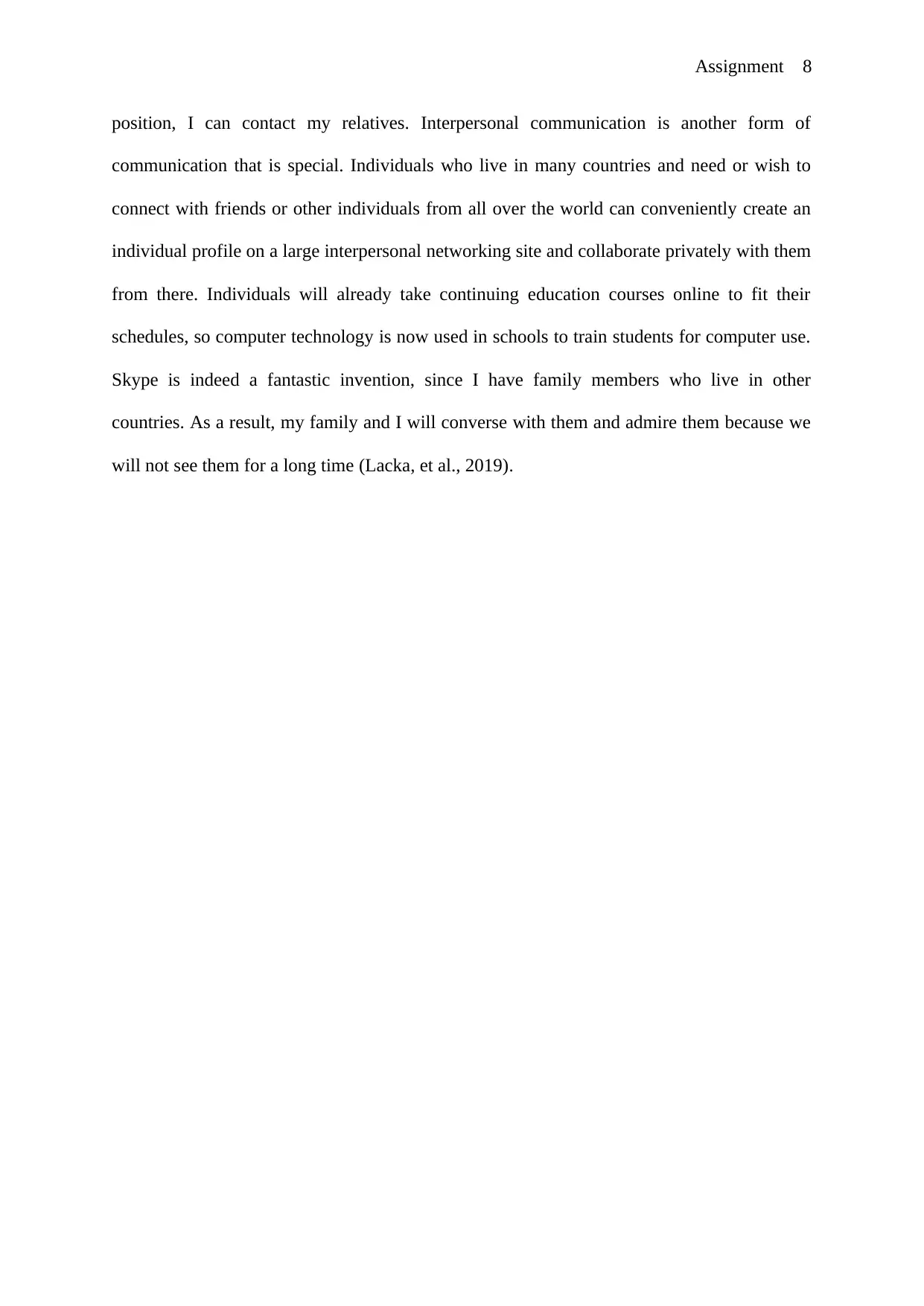
Assignment 8
position, I can contact my relatives. Interpersonal communication is another form of
communication that is special. Individuals who live in many countries and need or wish to
connect with friends or other individuals from all over the world can conveniently create an
individual profile on a large interpersonal networking site and collaborate privately with them
from there. Individuals will already take continuing education courses online to fit their
schedules, so computer technology is now used in schools to train students for computer use.
Skype is indeed a fantastic invention, since I have family members who live in other
countries. As a result, my family and I will converse with them and admire them because we
will not see them for a long time (Lacka, et al., 2019).
position, I can contact my relatives. Interpersonal communication is another form of
communication that is special. Individuals who live in many countries and need or wish to
connect with friends or other individuals from all over the world can conveniently create an
individual profile on a large interpersonal networking site and collaborate privately with them
from there. Individuals will already take continuing education courses online to fit their
schedules, so computer technology is now used in schools to train students for computer use.
Skype is indeed a fantastic invention, since I have family members who live in other
countries. As a result, my family and I will converse with them and admire them because we
will not see them for a long time (Lacka, et al., 2019).
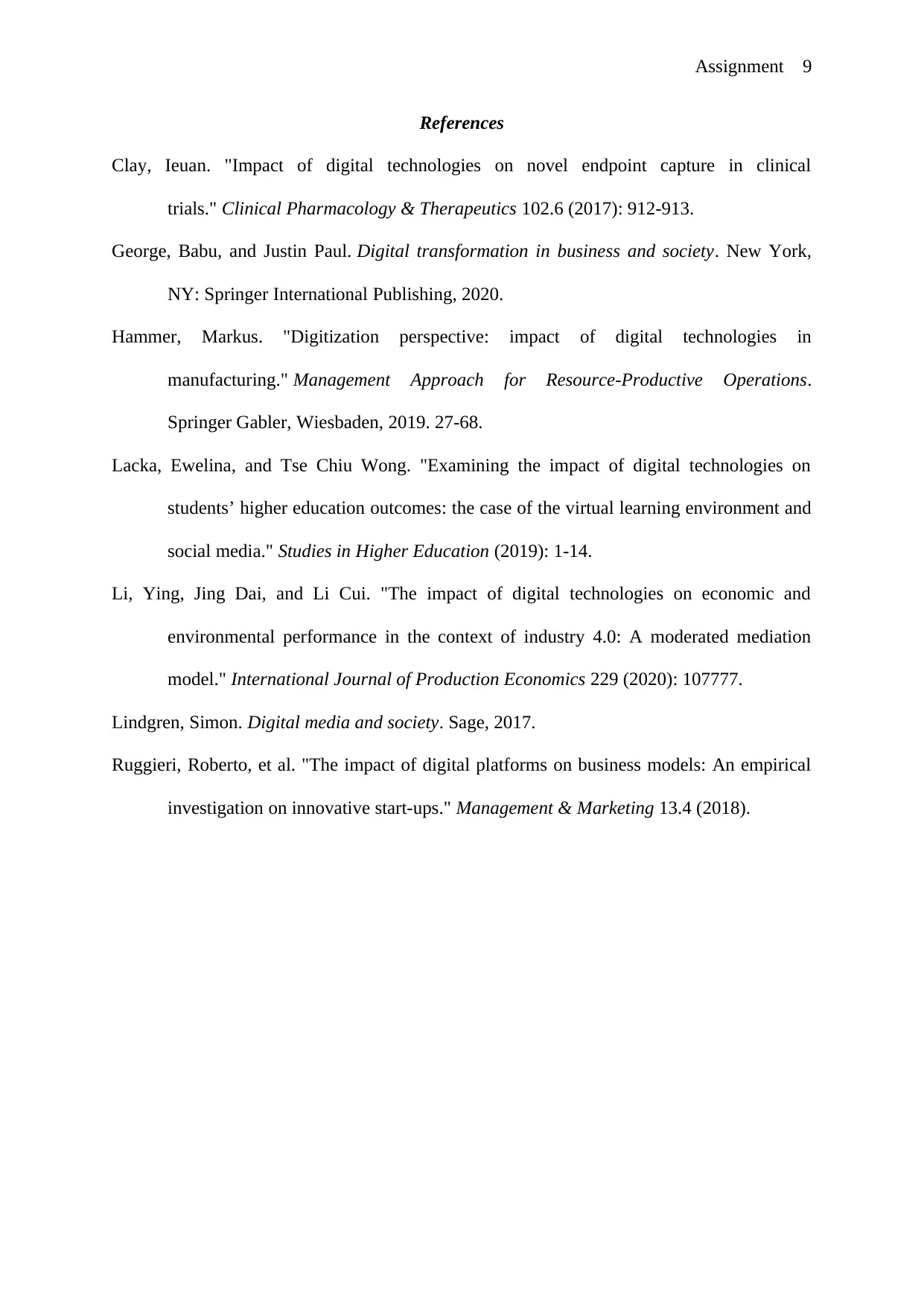
Assignment 9
References
Clay, Ieuan. "Impact of digital technologies on novel endpoint capture in clinical
trials." Clinical Pharmacology & Therapeutics 102.6 (2017): 912-913.
George, Babu, and Justin Paul. Digital transformation in business and society. New York,
NY: Springer International Publishing, 2020.
Hammer, Markus. "Digitization perspective: impact of digital technologies in
manufacturing." Management Approach for Resource-Productive Operations.
Springer Gabler, Wiesbaden, 2019. 27-68.
Lacka, Ewelina, and Tse Chiu Wong. "Examining the impact of digital technologies on
students’ higher education outcomes: the case of the virtual learning environment and
social media." Studies in Higher Education (2019): 1-14.
Li, Ying, Jing Dai, and Li Cui. "The impact of digital technologies on economic and
environmental performance in the context of industry 4.0: A moderated mediation
model." International Journal of Production Economics 229 (2020): 107777.
Lindgren, Simon. Digital media and society. Sage, 2017.
Ruggieri, Roberto, et al. "The impact of digital platforms on business models: An empirical
investigation on innovative start-ups." Management & Marketing 13.4 (2018).
References
Clay, Ieuan. "Impact of digital technologies on novel endpoint capture in clinical
trials." Clinical Pharmacology & Therapeutics 102.6 (2017): 912-913.
George, Babu, and Justin Paul. Digital transformation in business and society. New York,
NY: Springer International Publishing, 2020.
Hammer, Markus. "Digitization perspective: impact of digital technologies in
manufacturing." Management Approach for Resource-Productive Operations.
Springer Gabler, Wiesbaden, 2019. 27-68.
Lacka, Ewelina, and Tse Chiu Wong. "Examining the impact of digital technologies on
students’ higher education outcomes: the case of the virtual learning environment and
social media." Studies in Higher Education (2019): 1-14.
Li, Ying, Jing Dai, and Li Cui. "The impact of digital technologies on economic and
environmental performance in the context of industry 4.0: A moderated mediation
model." International Journal of Production Economics 229 (2020): 107777.
Lindgren, Simon. Digital media and society. Sage, 2017.
Ruggieri, Roberto, et al. "The impact of digital platforms on business models: An empirical
investigation on innovative start-ups." Management & Marketing 13.4 (2018).
⊘ This is a preview!⊘
Do you want full access?
Subscribe today to unlock all pages.

Trusted by 1+ million students worldwide
1 out of 9
Related Documents
Your All-in-One AI-Powered Toolkit for Academic Success.
+13062052269
info@desklib.com
Available 24*7 on WhatsApp / Email
![[object Object]](/_next/static/media/star-bottom.7253800d.svg)
Unlock your academic potential
Copyright © 2020–2025 A2Z Services. All Rights Reserved. Developed and managed by ZUCOL.





